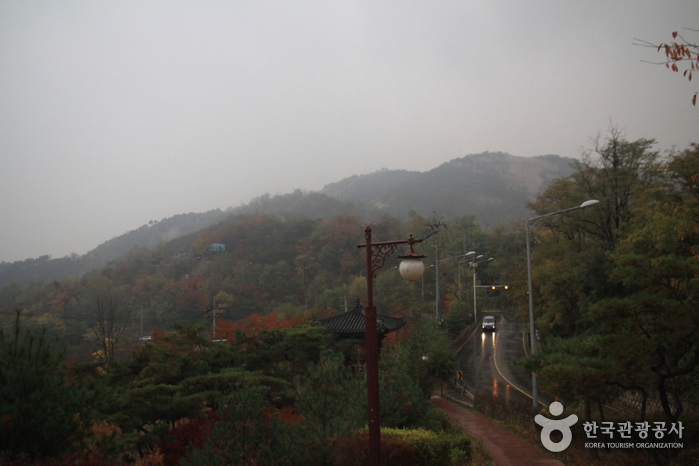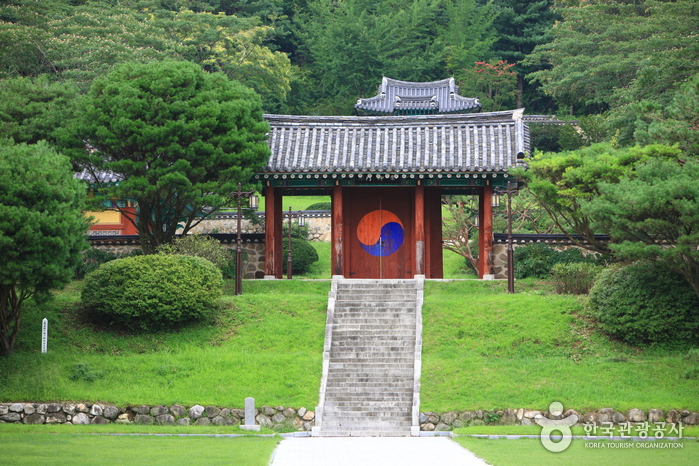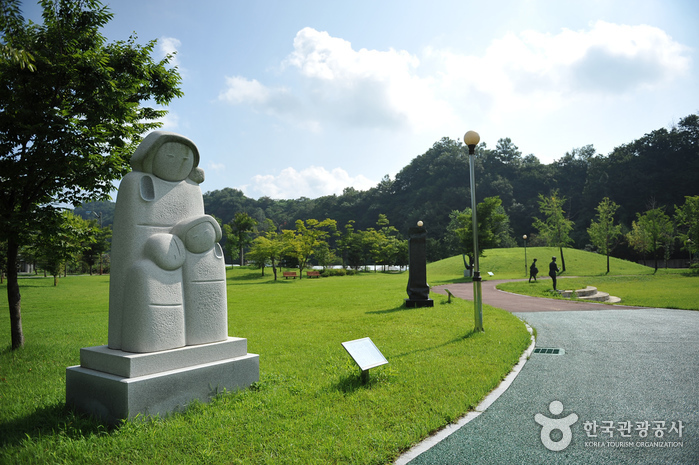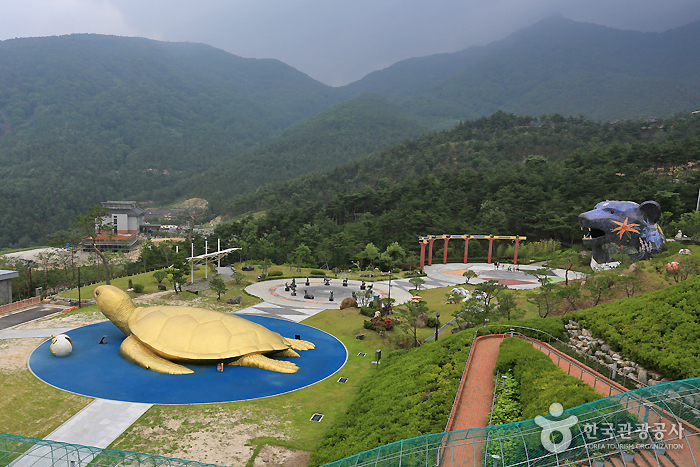Inwangsan Mountain (인왕산)
2024-03-04
San 2-1, Muak-dong, Jongno-gu, Seoul
+82-2-2148-2834
Inwangsan Mountain is a rocky mountain located to the northwestern side of Seoul. It stands 338m tall. The Seoul City Wall is built along its ridge, connecting to the Baegak Mountain Trail. From the summit, one can see the three mountains of Naksan Mountain, Namsan Mountain, and the Bugaksan Mountain surrounding the historical center of Hanyang, the historical name for Seoul in Joseon period, with the Gyeongbokgung Palace at the center. There are five hiking trails, all taking about two hours to complete. It takes about three hours if you want to visit all the peaks of the mountain.
Damyang Changpyeong Samjinae Village [Slow City] (담양 창평 삼지내마을[슬로시티])
2020-03-31
9-22, Doldam-gil, Damyang-gun, Jeollanam-do
+82-61-383-3807
Damyang Changpyeong Samjinae Village was the first Korean place designated as a slow city in 2007. Compared with the fast-changing city life, the village seeks a slow life, experiencing regional cultures and food, surrounded by nature. Visitors can make Korean traditional sweets & cookies such as Hangwa and Ssalyeot here.
Gurye Sansuyu Village (구례 산수유마을)
2020-04-25
6-12, Wianwolgye-gil, Gurye-gun, Jeollanam-do
+82-61-783-9114
Sandong-myeon in the Gurye-gun region is widely known as the home of sansuyu (cornus fruit) and is responsible for 70% of Korea’s sansuyu fruit production. The Sansuyu Village, located at the foot of the southwest side of Manbokdae Mountain (1,433 meters), is considered the region’s most representative village of sansuyu. The village has a beautiful natural landscape with the snow-covered Jirisan Mountain range to its back and a small valley to its right.
Visitors to the village can wind down at the hot spring complex nearby, which is famous for its germanium content and said to have numerous health benefits. The sansuyu flowers of Sansuyu Village typically are at full bloom between March 20 and March 31, drawing throngs of visitors.
* Please note that blossom dates are not exact and change slightly from year to year.
Nongae Shrine (Uiamsa Shrine) (논개사당(의암사))
2024-04-07
393, Hannuri-ro, Jangsu-gun, Jeonbuk-do
+82-63-350-2326
Uiamsa Shrine was built to the memory of Chu Nongae, who sacrificed her life during the Imjin War (Japanese Invasion of Korea). In 1846, the Nongae-saeng-jang-hyang-su-myeong-bi monument was put up in praise of Nongae’s patriotism. In 1955, a shrine was built and named Uiamsa, which was then moved to the current location in 1974. Within the precincts of the shrine are a memorial stone, the portrait of Nongae by artist Kim Eun-ho, and three gates Woesammun, Naesammun and Chunguimun erected one after another. At the memorial hall, the existing possessions of Nongae and her husband General Choi Gyeong-hoe are on display. The annual Nongae Festival takes places on September 3rd by the lunar calendar, during which memorial services and cultural events are held to commemorate Nongae.
Saseondae Tourist Resort & Sculpture Park (사선대관광지&조각공원)
2024-04-07
68-7, Saseon 2-gil, Imsil-gun, Jeonbuk-do
+82-63-640-2921
Saseondae Tourist Area was established around the upper region of the Seomjingang River. The pine trees are dense, cherry blossoms bloom in spring, and autumn leaves are spectacular in fall in this area. At the Sculpture Park next to the Saseondae Tourist Area, visitors can enjoy sculptures by local sculptors and international artists from the nearby Ogung-ri Art Village.
Donguibogam Village (산청 동의보감촌)
2018-10-18
45-6, Donguibogam-ro 555beon-gil, Geumseo-myeon, Sancheong-gun, Gyeongsangnam-do
+82-55-970-7216
The Donguibogam Village (Sancheong Oriental Medicine Theme Park) was established in 2005 and is the first herbal medicine-themed park in Korea. This theme park was designed based on the five elements of the universe according to traditional Korean medicine. The village combines eco-friendliness and traditional Korean medicine content, using eco-friendly materials for various props and designs.
Oegosan Onggi Village (외고산옹기마을)
2025-03-28
36, Oegosan 3-gil, Ulju-gun, Ulsan
+82-52-237-7894
* Please be advised that this is located in one of the areas affected by the recent wildfire (as of March 27, 2025).
** For real-time wildfire information and emergency upates, visit the Korea Forestfire Information website and the National Disaster and Safety Portal.
Oegosan Onggi Village was established when earthenware master Heo Deok-man settled in the area in 1975. The village today showcases a massive collection of various earthenware products, which creates a unique sight. Over 50% of the country's earthenware products are crafted at this village. The village also features several attractions for visitors to enjoy, such as the Ulsan Onggi Museum, which houses the largest earthenware pottery recognized by the Guinness Book of World Records; and the annual Ulsan Onggi Festival, with many diverse activity programs.
Jangsupungdengi Village (장수풍뎅이마을)
2025-01-10
Banwol-ri, Yuchi-myeon, Jangheung-gun, Jeollanam-do
+82-10-3110-6145
Located in the far upstream of Jangheung Dam, Jangsupungdengi Village preserves the natural environment. The village has a shiitake mushroom center, eco experience center, and beetle farming field where children and teenage students may visit and learn about the nature and its eco system. The village is also open to the general public for quality time in nature.
Chungjang-ro Street (충장로)
2023-11-17
Jungjang-ro, Dong-gu, Gwangju
+82-62-608-2221
Chungjang-ro Street is Gwangju’s major fashion district, comparable with Myeongdong Street of Seoul. The streets of Chungjang-ro are lined with shopping malls, clothing stores, restaurants, cafes, movie theaters and various other attractions, providing the ultimate experience of modern culture in Gwangju. It is the city's hub of fashion, both trendy and traditional, as well as venue for diverse performances.
Daedunsan Provincial Park (Jeollabuk-do Section) (대둔산도립공원(전북))
2024-04-07
611-34, Sanbuk-ri, Wanju-gun, Jeonbuk-do
+82-63-263-9949
Daedunsan Mountain is defined by the grandiose rock peaks of Macheondae Summit, Chilseongbong, Janggunbong, and Ambong Peaks, as well as surrounding strange rocks and lush trees that fill the area including Samseonbawi Rock, Yongmungol Valley and Geumgangmun Gate. The area spanning from Macheondae Peak to Nakjodae Peak along the northern ridge offers a magnificent view, especially of the sunrise and sunset from Nakjodae.
Since its designation as a provincial park in 1977, Daedunsan Provincial Park has served as a scenic site equipped with recreational facilities including a cable car and Geumgang Suspension Bridge. A 5-minute cable car ride followed by a walk up the steep stairs leads to the suspension bridge, stretching 50 meters from Imgeumbawi Rock to Ipseokdae Pedestal. The park is also home to historic temples including Taegosa Temple of Jinsan, Ansimsa Temple of Unju, and Sinsounsa Temple of Byeolgok.

![Damyang Changpyeong Samjinae Village [Slow City] (담양 창평 삼지내마을[슬로시티])](http://tong.visitkorea.or.kr/cms/resource/56/898356_image2_1.jpg)






 English
English
 한국어
한국어 日本語
日本語 中文(简体)
中文(简体) Deutsch
Deutsch Français
Français Español
Español Русский
Русский